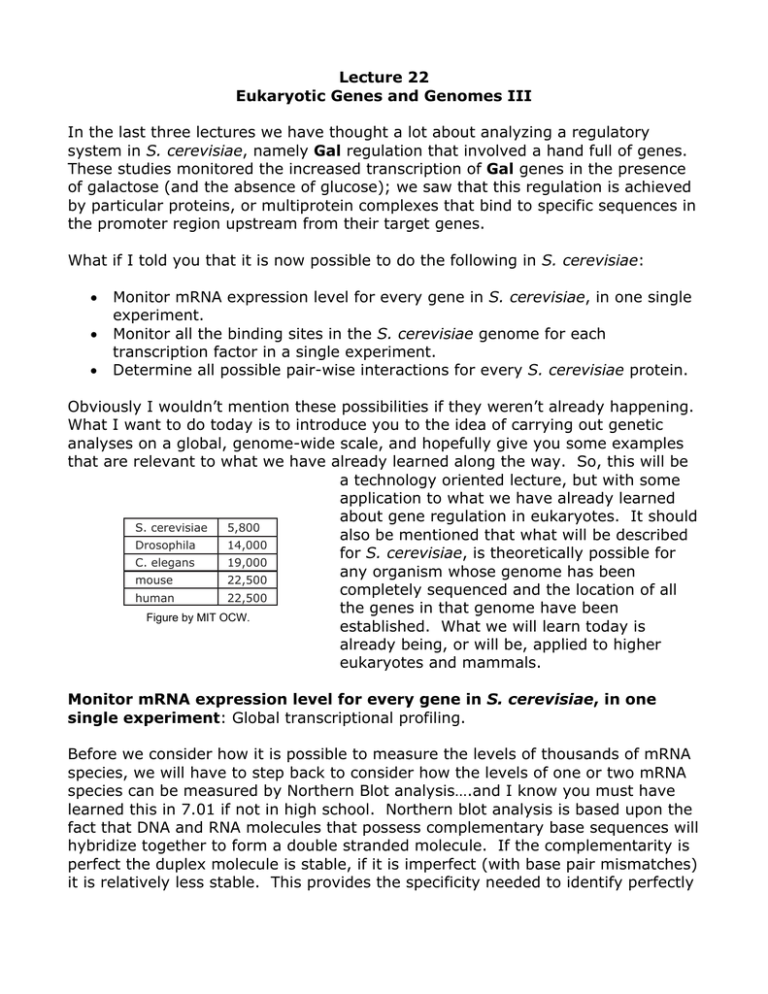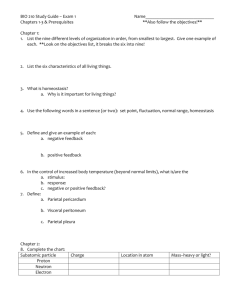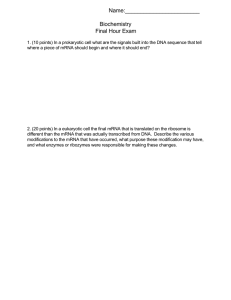Lecture 22 Eukaryotic Genes and Genomes III
advertisement

Lecture 22 Eukaryotic Genes and Genomes III In the last three lectures we have thought a lot about analyzing a regulatory system in S. cerevisiae, namely Gal regulation that involved a hand full of genes. These studies monitored the increased transcription of Gal genes in the presence of galactose (and the absence of glucose); we saw that this regulation is achieved by particular proteins, or multiprotein complexes that bind to specific sequences in the promoter region upstream from their target genes. What if I told you that it is now possible to do the following in S. cerevisiae: • • • Monitor mRNA expression level for every gene in S. cerevisiae, in one single experiment. Monitor all the binding sites in the S. cerevisiae genome for each transcription factor in a single experiment. Determine all possible pair-wise interactions for every S. cerevisiae protein. Obviously I wouldn’t mention these possibilities if they weren’t already happening. What I want to do today is to introduce you to the idea of carrying out genetic analyses on a global, genome-wide scale, and hopefully give you some examples that are relevant to what we have already learned along the way. So, this will be a technology oriented lecture, but with some application to what we have already learned about gene regulation in eukaryotes. It should S. cerevisiae 5,800 also be mentioned that what will be described Drosophila 14,000 for S. cerevisiae, is theoretically possible for C. elegans 19,000 any organism whose genome has been mouse 22,500 completely sequenced and the location of all human 22,500 the genes in that genome have been Figure by MIT OCW. established. What we will learn today is already being, or will be, applied to higher eukaryotes and mammals. Monitor mRNA expression level for every gene in S. cerevisiae, in one single experiment: Global transcriptional profiling. Before we consider how it is possible to measure the levels of thousands of mRNA species, we will have to step back to consider how the levels of one or two mRNA species can be measured by Northern Blot analysis….and I know you must have learned this in 7.01 if not in high school. Northern blot analysis is based upon the fact that DNA and RNA molecules that possess complementary base sequences will hybridize together to form a double stranded molecule. If the complementarity is perfect the duplex molecule is stable, if it is imperfect (with base pair mismatches) it is relatively less stable. This provides the specificity needed to identify perfectly matched DNA:RNA duplexes (on Northern Blots) and DNA:DNA duplexes (on Southern Blots). This specificity is needed to be sure we are measuring the level of one particular transcript and that this is not contaminated with signal from closely related transcripts. RNA is isolated from cells, size fractionated on a gel; the thousands of mRNAs species form a smear on the gel which is punctuated by the strong ribosomal RNA bands (28S and 18S) that do not interfere with the analysis. Image removed due to copyright reasons. Please see http://www.accessexcellence.org/RC/VL/GG/nucleic.html Figure by MIT OCW. Northern Blots Immobilized mRNA population hybridized with labeled DNA probe representing one or two genes DNA Microarrays Immobilized DNA probes representing all possible genes hybridized with labeled mRNA population DNA Clones PCR amplification purification robotic printing hybridize target to microarray Figure by MIT OCW. The breakthrough in developing microarrays for analyzing mRNA levels was to reverse the logic – instead of immobilizing the mRNAs for hybridization with one or two labeled complementary DNA (cDNA) probes, all possible cDNA probes are immobilized on a solid surface (usually glass slides). The spotting of probes is achieved robotically; the DNA probes are designed to specifically hybridize to only one nucleic acid sequence that represents a single mRNA species. The thousands of DNA probes are dispensed from 96-well, or 384-well plates to an addressable site on the solid surface. The mRNA population from each cell type purified and then copied such that the copy is fluorescently labeled. This fluorescent population is hybridized to the immobilized probes, and the intensity of the fluorescence at each probe spot is proportional to the number of copies of that specific mRNA species in the original mRNA population. So let’s look at how this would actually work in a real experiment. mRNA is isolated from yeast cells in state A (e.g., minus galactose) and from yeast cells in state B (e.g., plus galactose), and copies of each population is made such that one fluoresces red and the other fluoresces green. After mixing, these fluorescent molecules are hybridized to the slides containing ~5,800 DNA probes, each one specific for detecting hybridization of many copies of an individual mRNA species. Yeast in state A What’s happening at each spot? Yeast in state B Isolate mRNA populations AAAAA AAAAA AAAAA AAAAA AAAAA AAAAA AAAAA AAAAA Label copies of mRNA species with RED or GREEN TTTTT TTTTT TTTTT TTTTT TTTTT TTTTT TTTTT TTTTT MIX TTTTT TTTTT TTTTT TTTTT TTTTT TTTTT TTTTT TTTTT Hybridize to the microarray mRNA present much higher in State A than State B mRNA present much higher in State B than State A mRNA present at equal levels in States A and B Hybridization The location and identity of each probe on the microarray slide is known, and each probe is specific for a single mRNA. The color and intensity of the fluorescence is measured by scanning the slide with lasers, and the relative abundance of each mRNA in the cells of State A vs State B can be calculated from the emitted fluorescence. i.e., the relative level of 5,800 mRNAs can be compared between two populations of yeast cells. Presenting data for thousands of mRNA transcripts is clearly a challenge. You could present endless tables of data, but our brains are much more adept at recognizing shapes, patterns and colors. Colored representations of up and down regulation of transcripts levels is the preferred way to present data. Northern Blot vs. Microarray Each colored vertical line in the horizontal lane displays the relative expression level of a single mRNA Images removed due to copyright reasons. Please see Lodish, Harvey, et. al. Molecular Cell Biology. 5th ed. New York : W.H. Freeman and Company, 2004. For our purposes here, let’s look at what genes are up-regulated when a glucose grown culture of S. cerevisiae is shifted into galactose; what genes are upregulated under these conditions? Obviously transcripts for Gal1, Gal7 and Gal10 genes will be up-regulated, as we have discussed in the last couple of lectures. In addition Gal2 (galactose What transcripts have increased levels permease) and Gal80 (the negative when shifted from glucose to galactose? regulator of the Gal4 transcriptional activator) are also induced; this was previously known, although we didn’t Images removed due to copyright reasons. discuss it directly in the previous lectures. Please see Ren, Bing., et.al. "Genome-wide Location But upon looking globally, it has become and Function of DNA Binding Proteins." clear that some other genes are also upScience 290, no. 5500 (Dec. 22, 2000): 2306-9. regulated. (This figure shows just a small snapshot of the response.) These additional genes are Fur4, Gcy1, Mth1, and Pcl10, and their co-regulation along with the Gal genes was previously unrealized. We will be coming back to this later in the lecture. Monitor all the binding sites in the S. cerevisiae genome for each transcription factor in a single experiment. In the last lecture we talked about deletion analysis of cis-acting regulatory sequences identifying the location of UAS and URS sequences upstream of the Gal1 gene. That the Gal4 transcriptional activator protein binds to the DNA sequence present at the URSGAL1 can be shown to happen in the test tube, but showing that it is actually bound in a living cell is another matter. A method was recently developed for doing just that, and this method has been further developed to determine transcription regulator binding across the whole genome. Chromatin Immuno Precipitation (ChIP) Living cells H2CO Formaldehyde treatment crosslinks proteins to DNA DNA fragments that the transcription factor was bound to in the living yeast cell Isolate DNA with proteins crosslinked, shear into small fragments Reverse the formaldehyde crosslinks and get rid of protein Immunoprecipitate specific transcription factor and its bound DNA Images removed due to copyright reasons. Please see Figure 2 in Weinmann, Amy S. Novel ChIP-based Strategies to Uncover Transcription Factor Target Genes in the Immune System. Nature Reviews Immunology 4 (2004): 381-386. This method takes advantage of the fact that formaldehyde crosslinks proteins to DNA in a way that can later be reversed. For galactose grown yeast cells chromatin immunoprecipitation (ChIP) with an antibody that pulls down the Gal4 protein A more complete view of galactose revealed some surprises. In addition to induced gene expression in S. cerevisiae confirming that Gal4 binds to the promoters regions upstream of the expected Gal genes, Images removed due to copyright reasons. the Gal4 protein also binds to the promoter Please see Ren, Bing, et. al. "Genome-wide regions of 4 other genes, namely Fur4, Pcl10, Location and Function of DNA Binding Proteins." Mth1 (shown in the adjacent figure) and Gcy1 Science 290, no. 5500 (Dec. 22, 2000): 2306-9. (not shown). Note that these genes were shown to be induced by galactose in the previous section. Just how the up-regulation of Fur4, Pcl10 and Mth1 might contribute to optimizing the metabolism of galactose is shown in this figure, but the role Gcy1 plays is unclear. Clearly, taking a global look at what genes are up-regulated in the presence of galactose, and taking a global look at what promoters are bound by the Gal4 regulator, has clearly enriched our view of how S. cerevisiae adapts to the presence of this sugar. The ChIP approach, followed by hybridization to DNA microarrays, was originally limited to monitoring binding of transcriptional regulators for which there Images removed due to copyright reasons. Please see Ren, Bing, et. al. "Genome-wide were good precipitating Location and Function of DNA Binding Proteins." antibodies. However, this Science 290, no. 5500 (Dec. 22, 2000): 2306-9. limitation was recently eliminated by fusing an Arrayed probe epitope TAG to each sequences represent the upstream cisregulator gene. This acting regions of all epitope TAG is recognized 5,800 genes by a strong antibody, and so a single antibody can “pull down” Regulatory Protein Regulatory Protein Gene Promoter (immunoprecipitate) >100 different binds Gene Promoter regulatory proteins, each of which is expressed in its own yeast strain. This has enabled a massive study to identify all of the target genes for each of 106 transcriptional regulators in S. cerevisiae growing in a defined medium. A compilation of all the data has revealed a number of fundamentally different regulatory motifs; these are shown in the adjacent figure. For the most part the Gal4 regulatory network (not shown) represents a simple Single Input Motif. This approach has already been extended to human cells and it will not be long until detailed regulatory mechanisms are defined for humans, in the way it is now happening in yeast. It is now possible to go on to monitor which genes the transcriptional regulators bind to under different environmental conditions, and from there to build more dynamic models for how these genetic regulatory mechanisms operate and ultimately how they co-operate with each other. Determine all possible pair-wise interactions for every S. cerevisiae protein. The third global scale analysis we will consider is the systematic determination of protein-protein interactions in S. cerevisiae. This essentially involves a systematic test of all pair-wise combinations between all 5,800 yeast proteins. Individual matings to test >33 million combinations isn’t feasible, so mating pools of 100 strains in Positive interaction all Gal4 chimeric proteins representing all 5,800 Gal4-AD Increased transcription proteins fused to the Gal4 Activation Domain combinati x z and to the DNA Binding domain. Gal4-BD ons has Gal4 DNA Binding Domain One of 5,800 proteins become GAL4-binding Reporter gene site the LacZ, URA3, HIS3 5,800 Matα yeast strains Individual strains preferred 5,800 Matα strains X 5,800 Mata One of 5,800 proteins Gal4 Activation Domain 33,640,000 matings Select for diploids strains approach. that can grow in the Pools of 100 strains Only the absence of Uracil 5,800 Mata yeast strains 58 pools Matα strains X 58 pools Mata and Histidine and strains 3,364 matings diploid which are blue on X-gal strains Figure by MIT OCW. where the Gal4 DB-fusion and the Gal4 AD-fusion proteins interact will be able to grow on galactose medium without uracil and histidine, as well as turning blue when grown on galactose and X-gal. The plasmids present in such diploids are then sequenced to determine which proteins are fused to the Gal4 AD and DB domains. This systematic approach to cataloguing all possible protein-protein interactions for yeast proteins yielded many more Embedded in this complex web of interactions interactions that originally thought. Admittedly we can find those proteins that bind Gal4 the yeast two hybrid is quite noisy, giving many • Gal1 can pinch-hit for Gal3 Gal 1 false positive interactions, but even so • Gal11 turns out to be a subunit of the PolII transcription machinery so alternative methods (that we do not have time Gal4 communicates with Gal 3 PolII Via Gal11 to consider in detail) have confirmed many of Gal 80 these interactions. When all of the known protein-protein interaction data is assembled, Gal 4 Gal 11 we see the surprising fact that > 5,000 proteins can be connected together by > 14,000 protein interactions in a continuous web. Indeed, the interaction data for Gal4 embedded within this web makes sense and adds some new information. Such “Interactomes” are being developed for all the usual organisms, and the C. elegans interactome is particularly well developed. One of the major revelations has been that proteins from pathways that were previously thought to be totally unconnected, turn out to have interacting proteins.






